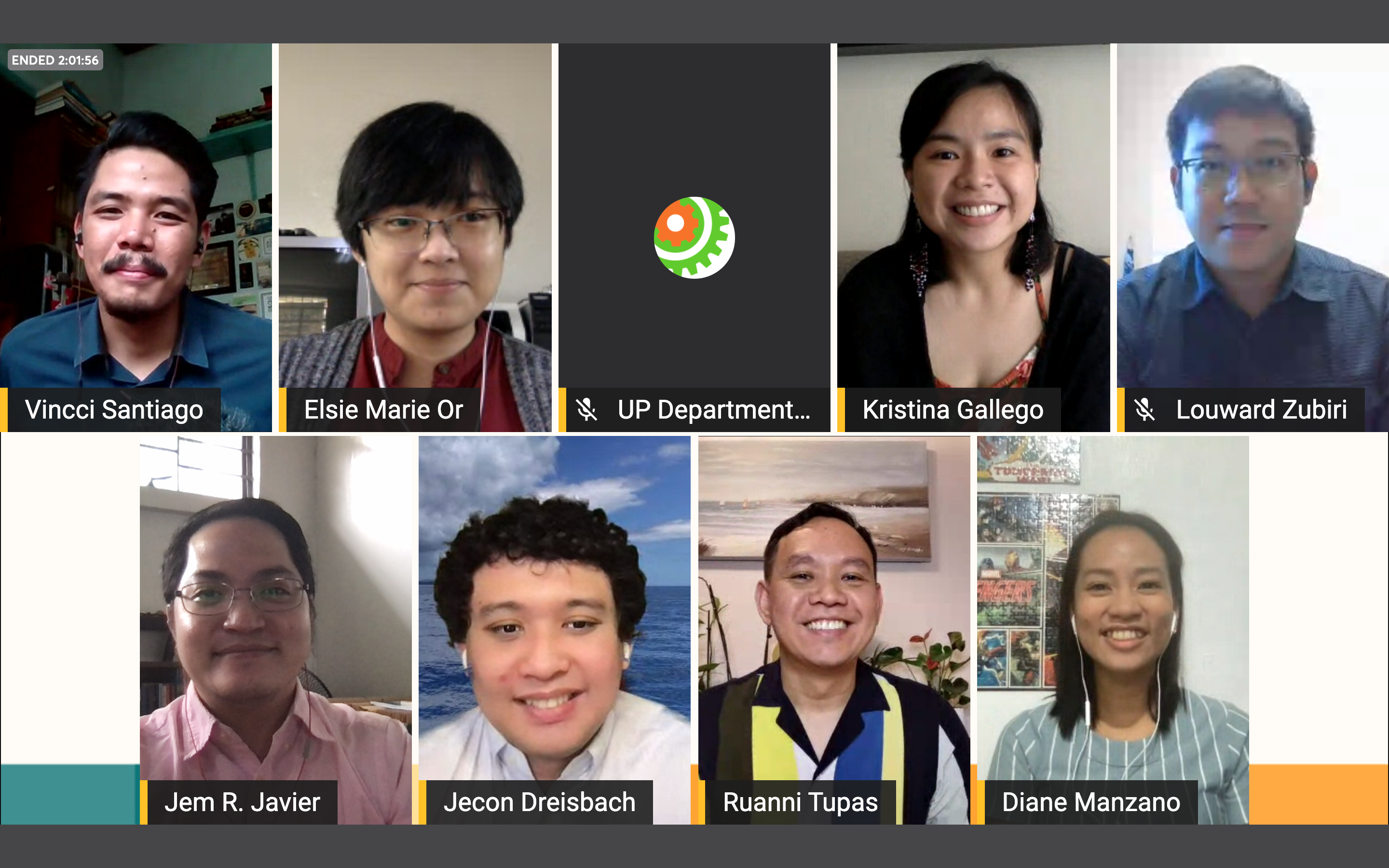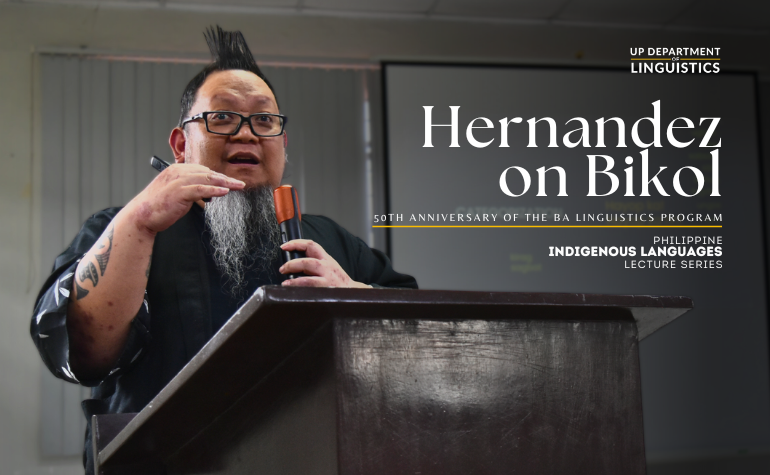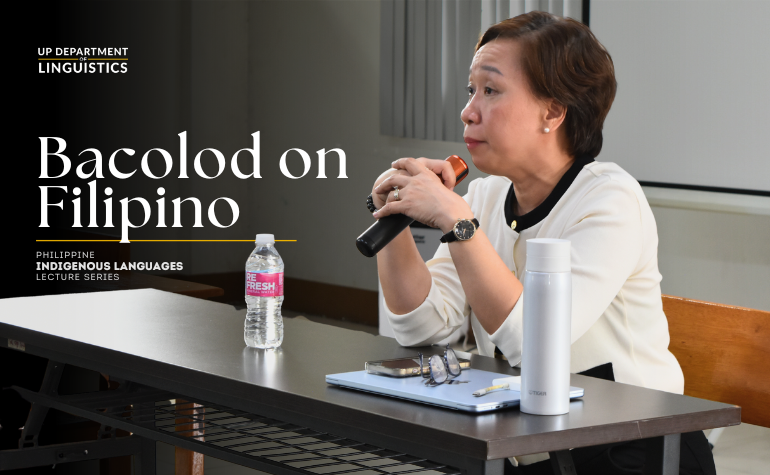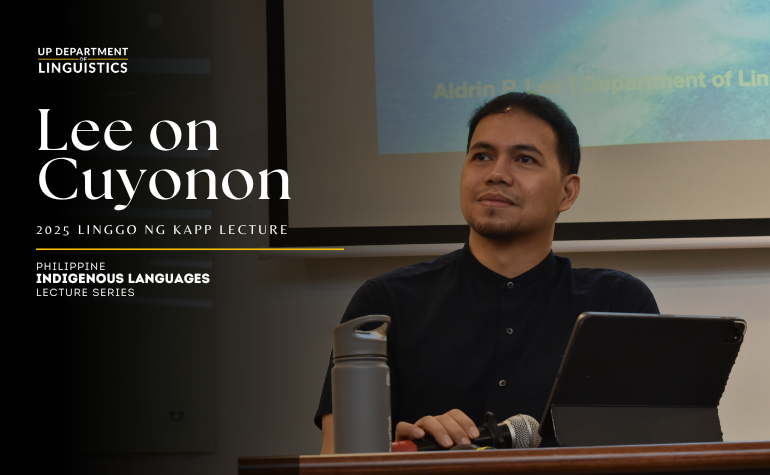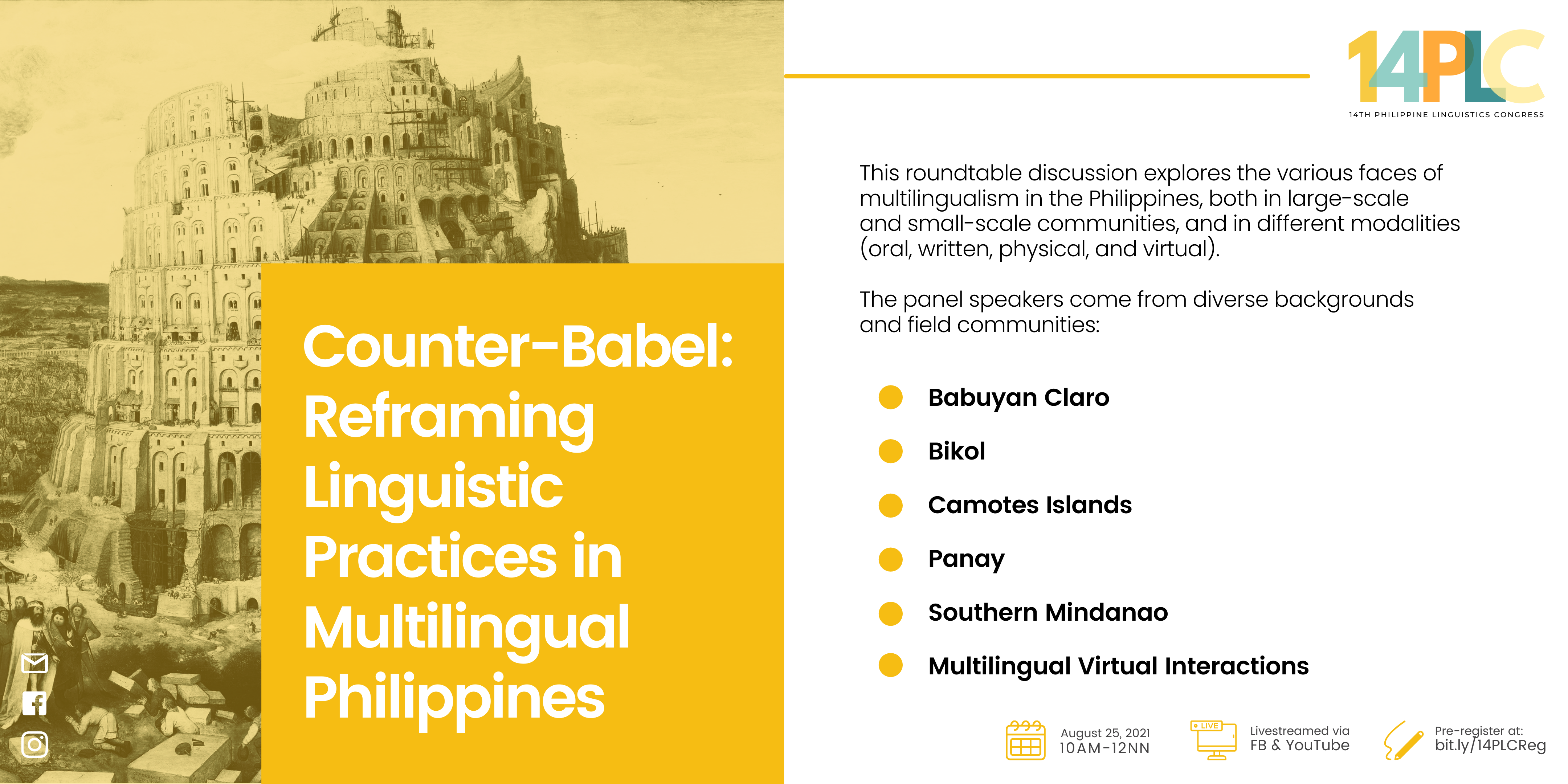
One of the five panel discussions held at the recently concluded 14th Philippine Linguistics Congress organized by the University of the Philippines Department of Linguistics essentially highlights how linguistically diverse the Philippines is and how ironically predisposed the linguistic practices are towards the perspective of monolingualism. In particular, the speakers look into the different aspects, challenges, and issues in accounting for multilingualism in the Philippines. The six speakers comprising this panel are academics who came from diverse backgrounds and field communities, namely, Louward Zubiri, a PhD student at University of Hawai’i at Manoa; Vincci Santiago, instructor at UP Diliman; Assistant Professor Diane Manzano of UP Los Baños; Jeconiah Dreisbach, lecturer at De La Salle University; Sociolinguist Ruanni Tupas of University College London; and Assistant Professor Maria Kristina Gallego of UP Diliman who also moderated the virtual discussion.
Counter-Babel
Probably, some are perplexed by the panel title, particularly the term ‘Counter-Babel’ consisting of the prefix counter– which denotes opposition, and Babel which is a biblical allusion to the Tower of Babel. In biblical literature, the Babylonians, who were believed to speak a single language at that time, attempted to build a tower tall enough to reach the heavens. Enraged by this arrogant pursuit of power, God mixed up the language of the builders so they could no longer understand each other and dispersed them all over the earth. This biblical narrative of the Tower of Babel in Genesis 11:1-9 presumably accounts for the origin of the multiplicity of languages, which is perceived as a divine punishment.
Although several centuries have already passed since the fall of Babel, there remains bias against multilingualism, which is reflected in various language policies and current linguistic practices and perspectives, among others. In the context of the Philippines which is the focus of this panel, linguistic practices lean towards monolingualism despite the country’s multicultural and multilingual nature. However, multilingualism is now the norm and this calls for a paradigm shift in terms of how we should view and deal with linguistic diversity and multilingualism.
The Philippines as a multilingual country
It is common knowledge that the Philippines, being an archipelagic country, is one of the regions in the world with a high index of linguistic diversity. According to Eberhard et al. (2021), the Philippines is a home to 186 languages, wherein 184 are living and 2 are extinct. Of the living languages, 175 are indigenous and 9 are non-indigenous. Being steeped in rich history and culture, the Philippines, as detailed by Santiago, also shelters a large number of languages that are genetically non-Philippine such as Chavacano, a Spanish-based creole spoken in Zamboanga City and Cavite province; Lannang-Oe or the Philippine Hokkien spoken by the ethnic Chinese population in the Philippines; and English, the country’s official language used in commerce, law, and education. Furthermore, the Philippines has Filipino as the national language and Filipino Sign Language or FSL as the country’s official language of the Filipino deaf community. As one may note, the Philippine linguistic ecology is evidently rich and diverse. However, the existing linguistic theories, constructs, and ideologies, language documentation practices, and language policies, among others, potentially threaten the multilingual and highly diverse linguistic ecology in the Philippines.
The different faces of multilingualism in the Philippines
As stressed in this panel, multilingualism is the norm in many parts of the world; hence, policy makers should start veering away from crafting policies and implementing programs anchored to a monolingual system. In the Philippines, multilingualism comes in many different guises and situations. In many large-scale societies, multilingualism emerges as a consequence of waves of migration, invasion, commerce and trade, and consequently language contact, a sociolinguistic phenomenon by which speakers of different languages or varieties interact and influence each other, which results in varying degrees of transfer of linguistic features from one language to another. This language contact situation between speakers of different languages, as expounded by Dreisbach, consequently gives rise to the emergence of hybrid languages, pidgins, and creoles. Pidgins and creoles are ‘language varieties’ that develop out of contacts between people who do not share a common language. Theoretically, a pidgin becomes a creole when it is learned as the first language and mother tongue of a community. However, unlike pidgins, creoles are more complex in terms of lexicon, morphology, and syntax. Notably, in the Philippines, there emerged a Spanish-based creole called Chavacano, which is largely spoken in Zamboanga City.
Moreover, multilingualism is influenced by geography. The geographical context of a language affects linguistic diversity. In general, linguistic diversity increases as geographic distance between speech communities increases. As Zubiri puts it, “Terrain affects language diversification and speciation.” In a discourse on language geography, one simply cannot leave out of the picture the concepts of boundary, language, and dialects. Language boundary pertains to an imaginary line that separates two language areas. It is established using mutual intelligibility as the main criterion. In linguistics, mutual intelligibility is the extent to which speakers from different speech communities can readily understand each other without prior familiarity and this test is ideally used for distinguishing languages from dialects. It is maintained that dialects of the same language should be mutually intelligible while different languages are not. In relation to multilingualism, determining language boundaries is complex, especially in urban centers where there are large-scale movements and apparently high level of linguistic diversity due to an influx of people with different ethnolinguistic backgrounds who are in search of a greener pasture.
In the context of small-scale communities, Gallego points out that multilingualism arises as a result of mixed ancestry and in these communities, multilingualism is mostly egalitarian unlike in large-scale communities where languages are stratified according to prestige, social class, and instrumental value in the job market, among others. A perfect example of this is none other than Babuyan Claro where she has been doing field research for years. According to her, the community descended from the intermarriage of Ilocano and Batanic speaking families, which results in the multilingual setting of the community. Furthermore, Gallego underscores that there arises a shift in language ecology whenever a small-scale community is integrated into a large one.
Finally, multilingualism comes under the guise of a multimodal interaction, which is prevalent in the digital context. In Tupas’ words, “The overlapping modalities used online implicates the use of different languages.” In a virtual environment where there is no border, people with different linguistic repertoires and ethnicity can freely and publicly engage in a conversation. There can still be an interaction where contact between people and thus contact between languages may happen, albeit behind computer screens. However, Tupas expresses its concern about the danger of looking at virtual linguistic practices of people who connect and communicate with one another in their respective languages as “different monolingualisms.”
Challenges and issues surrounding multilingualism
It is most likely that in a highly linguistically diverse community, there is also a high level of language endangerment. As conveyed by Manzano, one of the challenges that multilingual communities face is language attrition. It is the process where speakers lose their native or first language as a result of (1) isolation from fellow native speakers and (2) acquisition and use of a second language which is often more dominant and more economically and politically powerful than the first. As mentioned, language attrition ensues from language shift. Speakers leave their home communities and move to places that can offer them a brighter future and a better life. To accommodate their neighbors and gain more opportunities, they shift to a more economically privileged and beneficial language, which results in the use of their mother tongue being confined within the four corners of their homes and the use of a dominant language across many other domains. This practice apparently contributes to the endangerment of languages, particularly the minority languages, especially that in most cases grandchildren, if not even their children, completely shift to the dominant language, thereby failing to sustain intergenerational transmission. This only shows how integral language input is to the development as well as revitalization of languages.
The process of language shift seems to be observable in Boracay where Inati speakers, according to Manzano, prefer to learn English more than their native language. Boracay being a world-class tourist destination, people assert that they have the “linguistic capital” if they can speak in English, Manzano recounts. In general, this sociolinguistic phenomenon of language shift poses a serious threat to the maintenance of minoritized languages and the multilingual ecology of a community. If not reversed, it would result in language loss and lead to monolingualism.
Another challenge bordering on multilingualism is concerned with the stratification of languages according to prestige and power. This ideology that languages have “social status” influences the speakers’ attitudes towards languages and their motivation towards language learning and language use. As Tupas puts it, “It’s the hierarchy of languages that impacts language choices as well.” In a multilingual environment, this representation of languages is utterly detrimental to minoritized languages as it is often the dominant language that is used across all social domains while the use of minoritized languages is often restricted at home.
In Southern Mindanao, particularly in Davao, Dreisbach affirms that Tagalog, despite being the language of the minority in that area, is considered a prestige language “as it is used by the economic elite and the economic elite are close with the powerful people.” It is even considered a sociolect of people belonging to the middle class and those above it. This belief about languages apparently creates an atmosphere that does not promote a healthy multilingual environment as languages are teased apart and speakers of minoritized languages are looked down upon.
In addition, the country’s current language policy and linguistic practices remain to be a challenge for a multilingual Philippines. The implementation of the Mother Tongue-Based Multilingual Education (MTB-MLE) by the Philippine Government through its Education Department fails to engender its trumpeted goodness. According to Dreisbach, not only is MTB-MLE designed to mainly cater to student populations whose mother tongue is a dominant language, it also fails to account for the variations within a language. In Southern Mindanao, instructional materials, Dreisbach relates, are written in a Cebuano variety spoken in Mainland Cebu. These materials apparently fail to take into account the linguistic variations among the different Cebuano varieties and consequently create gaps among learners. As regards this, Zubiri highlights that materials development in relation to MTB-MLE as well as Indigenous Peoples Education should be contextualized to truly capture the nuances in language and language use. Moreover, he notes additional challenges and issues that arise in accounting for multilingualism in the Philippines and these have to do with language mapping and visualization, assessment of vitality and intergenerational transmission, and language documentation. For instance, with regard to language documentation, linguists are still transfixed to the idea of language purism as demonstrated in selecting language consultants. In practice, those who are ideally chosen as language consultants are non-mobile, older, rural males for they are believed to speak the pure and standard form of a language.
In general, the existing Philippine language policies and linguistic practices, instead of fundamentally supporting multilingualism, remain biased towards the perspective of monolingualism. This is because these mainstream practices were framed with expectations rooted in monolingual language ideologies. So, to better account for the multilingual contexts of the Philippines, there is a need to reframe the present linguistic practices and recognize that multilingualism is certainly the norm rather than the exception. In this regard, the panel speakers are one in saying that reframing the current linguistic practices entails the “re-construction” of practices informed by multilingual, rather than monolingual language ideologies, and the overall reframing of these practices starts from the acknowledgment that there is a problem, to begin with.
Speakers in the hot seat
During the open forum, the questions raised center on language policy and language endangerment. Zooming in on language policy, particularly the effectiveness and applicability of the Mother Tongue-Based Multilingual Education in the context of multilingual Philippines, Tupas firmly accentuates that people’s perceptions even in the context of MTB-MLE are still entrenched in monolingual tenets. Even with the full-swing implementation of this policy, the media of instruction at school remain restricted to a few languages. In a mother tongue classroom, the language of learning is limited to the language spoken by the majority of student populations and the variety of language spoken in urban centers; hence, a conflict on which language and language variety should serve as mother tongue in a classroom of multilingual learners inevitably arises. In this regard, Tupas asserts that teachers should allow their students to use whatever language they have in their actual linguistic repertoires for as long as it facilitates student learning.
Additionally, Manzano notes another language practice that actually impedes rather than facilitates language learning. According to Manzano, teachers often use negative reinforcement when promoting the use of a particular language and when prohibiting students to use another language. In reality, the use of negative reinforcement, Manzano asserts, hinders students’ opportunities to learn a language as students consequently choose not to speak and practice their communicative repertoires in different contexts due to the fear of committing mistakes and getting punished.
With regard to the latter, Zubiri asserts that the problem of language endangerment is related to other sociocultural issues and for most indigenous communities, this problem is related to land disputes. Similarly, Santiago affirms that language endangerment is multicausal and multidimensional in nature. To help get to the bottom of this problem, he gives emphasis to the fact that academics and researchers had a fair share of mistakes that contributed to this problem and that they should acknowledge this and learn from past mistakes.
In closing, multilingualism is the reality of the Philippines, being a home to over a hundred languages. Instead of looking at linguistic diversity as a curse, people should look at it as a positive phenomenon that should be espoused and supported. As languages carry with them unimaginable riches in knowledge and culture, people should establish linguistic practices and formulate language policies that support and nurture multiple languages in different contexts.
The recording of the discussion can be viewed on our YouTube channel.
Published by Jay Chester D. Usero

